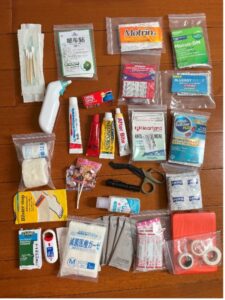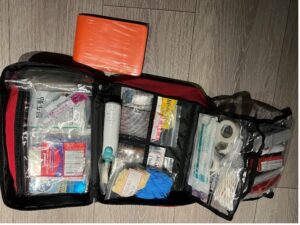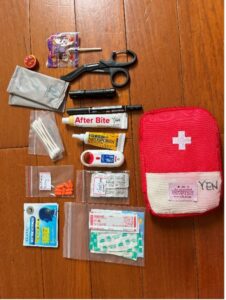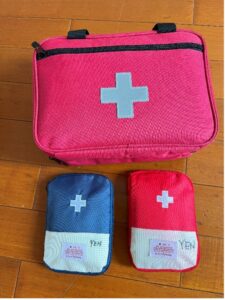The “Blue Box”, a briefcase-sized, hard plastic handheld case, is one item that every Peace Corps volunteer will never forget. Each “Blue Box” contains a variety of medicines, syringes, tourniquet, and the famous field medical guidebook “Where There Is No Doctor”. As a Peace Corps volunteer in Mali, West Africa in my early 20’s, I was 50 kilometers away from any medical clinic or any professional medical attention of any kind. The “Blue Box” was my back-stop to most illnesses that did not require a medical evacuation for the 27 months I spent in a rural village in Africa some 3 decades ago.
My experience in Africa continued to influence my urge to “be prepared” for any eventuality. This feeling is especially acute when the health and well-being of two adults and four children can make or break this remarkable year-long adventure around the globe. From bustling urban centers like Johannesburg to remote corners in Rajasthan, our travels will expose us to diverse environments, cuisines, and cultures, and of course a fair-share of medical issues, large and small. Of all the preparations required, perhaps one of the most essential, is assembling a comprehensive medical kit. Having the right supplies readily available can provide peace of mind and prevent minor issues from escalating into emergencies far from home.
In this post, I’ll share our thought process for stocking a medical kit designed specifically for the needs of my family. Much of my knowledge and experience came from my Peace Corps times in Mali, and also my heavy involvement with the Boy Scouts of America program, which three of my children actively participate in.
We started the planning with the more “routine” medicines that are used by our family. We then brainstormed possible out-of-the-ordinary scenarios and unexpected contingencies. The goal is to cover most of the bases with a selection of essential OTC medications (and a few prescriptions), first aid items and small medical tools – all while keeping size and weight reasonable for transit. We’ll go over the checklist we created and how we expect our medical supplies to serve us as we navigate this once-in-a-lifetime adventure spanning multiple continents and climates.
BTW, it was a pleasure working with my son RY (a Tenderfoot ranked Boy Scout) on this project. We had great discussions and debates on many of these items and how to make it useful and relevant. I also enjoyed working with AY (a Webelos Cub Scout) on down-sizing and organizing the meds into the various kits.
Part 1: The main Medical Kit
Our medical kit needs to be compact and lightweight yet robust enough to handle most minor injuries and illnesses for two adults and our four children. After some research and discussion, we organized our supplies into a few categories:
Basic First Aid
This covers basic wound care:
– Antiseptic wound cleanser to disinfect cuts or scrapes.
– Bandages, gauze, medical tape, and butterfly stitches for minor wounds
– Antibiotic ointment to prevent infections.
– Alcohol wipes for general disinfection.
Over-the-Counter Medications
Having the right OTC meds on hand can reduce the misery of common ailments:
– Acetaminophen and ibuprofen for fever or pain relief (we got chewable versions).
– Antihistamines for allergies.
– Hydrocortisone cream to for common skin irritations and itch relief.
– After-bite sting relief – help soothe itching from insect bites.
– Decongestants for colds and sinus issues.
– Cough suppressant and expectorant tablets (we try not to bring too many liquids).
– Anti-diarrheal medication
– Probiotics to ease stomach issues.
– Motion sickness patches and tablets
– Anti-fungal cream for skin rashes.
– Oral rehydration salts for dehydration (I got fruit-flavored ones so easier on children).
– Lucas’ Papaw Ointment: Gifted to us by two of our friends, apparently touted as the “miracle drug” for all kinds of skin irritations.
Prescription and Specialized Medications
A small supply of prescription meds we may need, including:
– Broad-spectrum antibiotics for bacterial infections (Dysentery, persistent coughs…)
– Anti-parasitic and amebic medication for dysentery
– Various eye drops to treat children’s eye infection or irritation.
Specialized gear:
Some of these items are helpful in various situations:
– A few Lollipops / Candies: Very important to keep children spirit high in stressful situations and medical emergencies.
– Small flashlight
– Medical scissors – Helpful for cutting bandages, removing foreign objects, etc.
– Tweezers – for splinters
– Digital thermometer
– Water purification tablets – for last-resort water treatment
– Small eye-dropper filled with Bleach – Interestingly this little eye-dropper was my best friend while in Mali, as it helped me treat every liter of drinking water with ease and confidence. It is by far the most compact and cost-efficient water purification method available.
– Splint kit – To immobilize minor fractures.
– Elastic bandages – To wrap sprains and splints.
– Medical gloves.
– Face masks and COVID-19 Testing Kits: We debated long and hard but still decided to bring some along, just in case! (update, COVID test kits did not make our final cut!)
General Packing Tips:
– Tablets vs Liquids: Even though many of children’s OTC meds are in liquid format, we tried to get most medicines in tablet or capsule form.
– Small Zip Lock Bags: To reduce bulk, we cut out and saved essential portions of OTC boxes and placed them with the meds in small zip lock bags. We also wrote clear instructions and dosage information on labels for easy reference by everyone.





Part 2 - The Daily Medical Kit
In addition to the main medical kit, we put together two “compact versions” so that Song and I can each carry one in our backpacks at any given time. This lightweight everyday kit provides quick access to medications and tools needed for basic first aid and common ailments when we’re out and about.
The daily kit includes:
– Wound cleanser, antibiotic ointment, bandages, tape, and alcohol wipes for minor cuts and scrapes
– Pain / fever medication like Tylenol
– Antihistamine tablets
– Insect bite cream
– Motion sickness patches
– Insect repellent
– Candy or Lollipop, again to ensure high spirit during stressful situations!
– Water purification tablets in case clean drinking water is not available.
– Mini medical scissors
– Marker Pen
– Small Pen light

While the original “Blue Box” has been replaced by a “Red Bag” on this trip, I do think we have carried on its important philosophical intent to “be prepared”. These medical kits should provide basic supplies to handle illness and injury during our year of global family travel. Though not meant to be all encompassing, it aims to alleviate most common issues and stabilize more serious conditions until professional care is available. I hope you will find the information here helpful for your own needs.

Author
-
Leo is the father of four children. He and his family have stepped away from it all and in September 2023, began traveling the world while homeschooling. Leo was raised in both Taiwan and the US and has spent the last 20+ years in Asia and Greater China. He earned his bachelor degree from Cornell’s Hotel School and MBA from MIT. He has worked in consulting, finance and the real estate side of the hospitality industry for most of his professional career, after serving two years in the Peace Corps in Mali, West Africa. He loves travelling, cooking, working with his hands and just about anything to do with the outdoors.


Omg!!! This post made me laugh thinking about our last conversations!!! LOL how you guys are jokingly arguing about how big the whole packages are!!! lol 🤣🤣🤣 but really well done you guys!!! Looks like you are all set!!! Never seen that much prepared medical supply kit in my life! Much well organized than my cabinet in our house. You are so pro at this!! Medical challenges came to my mind when I heard about these kind of trip, but you are all well prepared!! So just have fun!!!! 💓💓💓 Thank you for making us feel less things to worry about! Have a great first step of your journey!!! Looking forward to your next post! Without any pressure. Enjoy each moment. Love you guys!!! Ru
: )
Hello Leo, I wish your family all the best during this year of great adventures! I will be following your blog. Please remember to verify if there are restrictions for bringing in or declaring certain types of medications for each country that you will be visiting.
Arnaldo! Long time no see!!! Hope you are well! Where are you nowadays? Leo
Love reading about your preparations! Depending on how far afield you will be going, a couple of small additions to the kit might be –
*one or two large waterproof transparent film type bandages (for example, to safely cover/seal a whole abrased palm or knee for days)
*similarly a small tube of superglue for closing/sealing small wounds (my bro is an emergency MD and says they use it all the time)
*a sheet of moleskin has saved my adventuring more than once!
*and of course, duct tape 🙂
Can’t wait to watch your adventures!
Great suggestions Marie! Long time no see!! Hope you are well!
Very thorough. You have covered just about every situation. What about snake bite?
Good question! Let’s hope we don’t get that deep into the bush!
Great job ! As you might write other useful / instructive / educative blogs in the future, may I suggest to add a “share” function ? 😄🌳
Just did, thanks for the suggestion!
Pingback: “Be Prepared” – The Essentials of Our Travel Toolkit